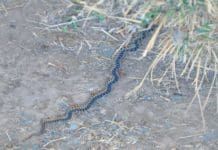Earth-Friendly Dog Poop Disposal
Lots of us go out of our way to look for biodegradable dog waste bags. After all, we want to be earth-friendly in as many ways as possible. Who wants to think of their dog's poop festering away in a traditional polymer bag designed to survive a zombie apocalypse? Unfortunately, the term biodegradable" isn't all it's cracked up to be. Truth is
Advocate for Your Dog
Willow. She scans for hazards (snakes
Keep Your Dog Safe from Water Hazards
We've had some intense heat in California lately, and lots of dog owners are taking their dogs to pools, lakes, rivers, and the coast to cool off. Allow me to remind you about several water-safety tips to keep in mind: Too much can be a bad thing. "Water toxicosis" can affect any dog who drinks too much in the course of swimming, dock diving, fetching toys from water, biting at a sprinkler, or any other activity that involves water. When dogs are hot or particularly excited, they may drink even more. If you notice your dog drinking more than seems necessary - especially if you notice him wobbling, vomiting, or seeming suddenly lethargic, have him take a break in the shade for a while, until his body can catch up and eliminate some of that excess. See https://www.whole-dog-journal.com/care/water-intoxication-in-dogs/
Why is Blue-Green Algae Dangerous to Dogs?
Water is wonderful, but not if it's toxic. When conditions promote the growth or bloom" of toxic blue-green algae in lakes and ponds
Symptoms of Heat Stress
A dog exhibiting any of these symptoms needs immediate veterinary care as brain damage, kidney failure, seizures, and death can occur:
Short-Nosed Dogs
The brachycephalic breeds such as Pugs, Boston Terriers, Boxers, Bulldogs are particularly at risk of heat stress, says Eileen Fatcheric, DVM, of Syracuse, New York. The only way dogs have to thermoregulate their bodies is panting
How to Keep Your Dog Cool in Hot Weather
Dogs find summer's high temperatures challenging. That's largely because they don't sweat. Sure, you've read that dogs have sweat glands in their paws, but veterinarians agree that's not much help. A dog's primary means of cooling himself is through panting and our goal is to make this process more efficient.
Letters and Corrections: June 2015
In the May issue, we published an article, Outfoxing Foxtails
Why Are The Effects Of Snake Venom So Varied?
Snake venom consists of proteins, enzymes, substances with a cytotoxic (poisonous to living cells) effect, neurotoxins (which damage nerve cells), and anti-coagulants. Four distinct types of venom act on the body differently.
A Snake-Bite Survival Story
On October 25, 2013, three days before his dog's fifth birthday, Dan Owen of Helena, Montana, went pheasant hunting with his friend Doug Denler in Shonkin, Montana, 40 miles east of Great Falls. Owen's Golden Retriever, Dusty, and Denler's Brittany Spaniel, Radar, were experienced hunters.It's really desolate looking country
Are You Sure It Was A Rattlesnake?
Snakes and dogs are a bad combination in any circumstances, but it's helpful to know what venomous snakes look like, both where you live and where you might be traveling.
Appreciating Rattlesnakes
Rattlesnakes fill most of us with fear and anxiety. For many, the only good snake is a dead snake.
















